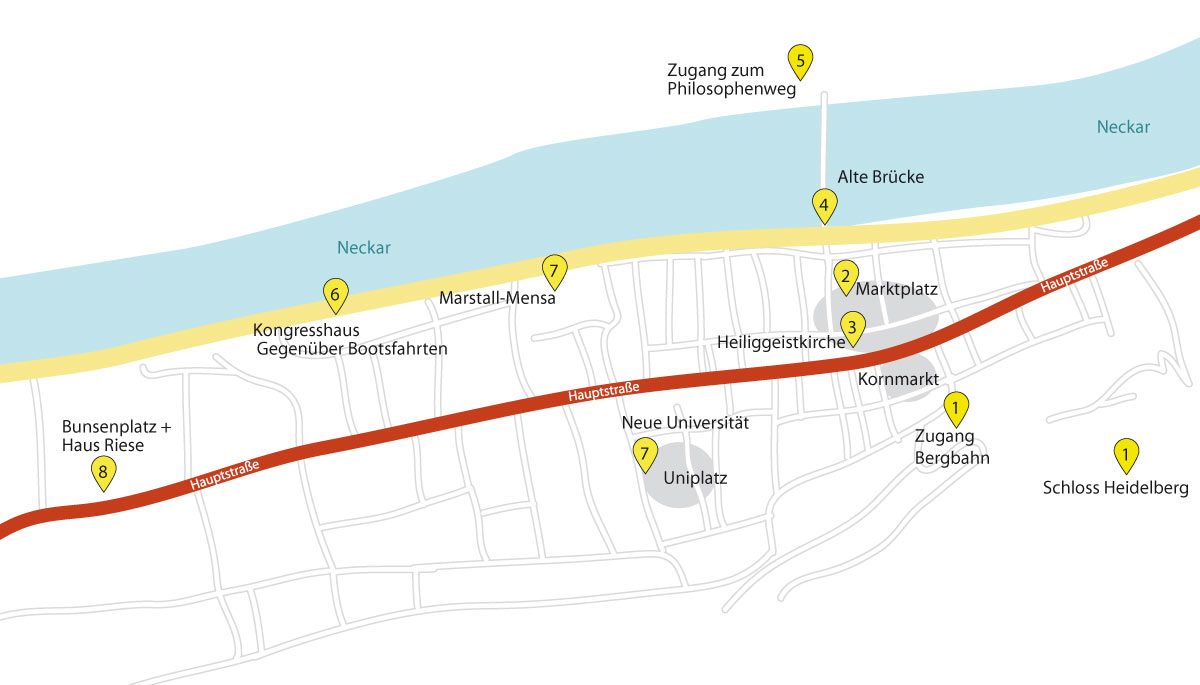Tips for trips
The old Bridge of Heidelberg
A special charm
To stroll on the old bridge has a very special charm.
The view of the Neckar and the castle is hardly more beautiful than there. In addition, there are countless small details to discover that tell a story about the Old Bridge.
And last but not least you can take a close look at the larger-than-life builder Karl Theodor.
The new stone bridge
The Old Bridge, made of Neckar Valley sandstone, was built in 1788 under Elector Karl Theodor as the ninth bridge on this site.
The "Old Bridge" was actually the new bridge, at least back then.
The previous bridge was destroyed in the catastrophic ice flood of 27 February 1784.
The winter of 1783/1784 had been exceptionally cold and snowy. When thaw finally set in at the end of February, this led to the heaviest flooding that Heidelberg has experienced in historical times.

How high the tide was,
can be seen on a marker on the first bridge pier.
Only two weeks after the flood, planning for the reconstruction of the bridge began.
It was discussed whether a wooden or stone arched bridge should be built on top of the existing stone piers.
Elector Karl Theodor awarded the contract to a plan to build the bridge as a stone construction.
High construction costs - and how to finance them
The stone construction was of course much more expensive than a wooden reconstruction.
The bridge construction cost a total of 165,282 gulden.
The bridge was thus the most expensive building in the former Electoral Palatinate after the Mannheim Castle.
The city of Heidelberg had to raise the money. It had to go into debt for this and as a result imposed a special tax on its citizens.
Karl Theodor and his Minerva
If you enter the Old Bridge from the city through the gate, you will directly encounter the statue of the builder Elector Karl Theodor.
The monument shows him larger than life in an imposing pose and stately diminutive - with armour, ermine coat and allon wig - looking over the bridge gate to the castle.
The statue of the Elector was erected in the year of the dedication of the bridge 1788.
When Karl Theodor inspected the bridge in the same year, he found that a statue of Minerva should be placed on the other side as a counterpart.
This was then completed in 1790.
Minerva plays a major role in Karl Theodor's classicist picture program, for example, he had a temple built for her in the park of Schwetzingen Castle.
Minerva is the goddess of the arts and sciences, whose patron Karl Theodor saw himself as.
The bridge monkey
From the early 17th century, the former northern bridge tower was decorated with the relief of a monkey, who grabbed his backside while holding up a mirror to himself.
Martin Zeiller wrote a poem about the ape in 1632 in his work Itinerarium Germaniae:
What sotu staring at me here?
Have you not seen the old monkey
Zu Heydelberg / sich dich hin unnd her /
Da findestu wol meines gleichen mehr.
During the destruction of 1689 the monkey tower was blown up and the bridge monkey was lost.
In 1977 the Alt-Heidelberg association announced a competition for a modern redesign of the bridge ape, which was decided in favour of a design by the sculptor Gernot Rumpf.
The bronze sculpture, created in 1979, takes up the motif of self-reflection by presenting the viewer with a mirror to be interpreted metaphorically.
Next to the monkey is the aforementioned mocking poem.

The head of the monkey is hollow,
so you can stick your own head inside it -
a motif that is often used for souvenir photos.
The mice and the corn
If you look closely, you will discover two small mouse figures at the feet of the monkey.
Just a nice playful detail? Not at all.
The two mice remind us of the electoral granary, which used to be located on this site next to the bridge gate.
Image rights:
Alle Bilder sind Aufnahmen und damit Eigentum von Christina Grab.
